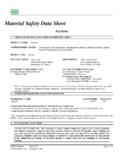Transcription of Liquid Nitrogen Material Safety Data Sheet (MSDS) …
1 Liquid Nitrogen Material Safety data Sheet ( msds ) 3/14/08 10:09 AM. Liquid Nitrogen Material Safety data Sheet . SECTION 1. PRODUCT IDENTIFICATION. PRODUCT NAME: Nitrogen , refrigerated Liquid CHEMICAL NAME: Nitrogen FORMULA: N 2. SYNONYMS: Liquid Nitrogen , LIN, Cryogenic Liquid Nitrogen , Nitrogen MANUFACTURER: Air Products and Chemicals, Inc. 7201 Hamilton Boulevard Allentown, PA 18195-1501. PRODUCT INFORMATION: 1-800-752-1597. msds NUMBER: 1041 REVISION: 5. REVISION DATE: July 1995**. SECTION 2. COMPOSITION/INFORMATION ON INGREDIENTS.
2 Nitrogen is sold as pure product > 99%. CAS NUMBER: 7727-37-9. EXPOSURE LIMITS: OSHA: Not established ACGIH: Simple asphyxiant SECTION 3. HAZARD IDENTIFICATION. EMERGENCY OVERVIEW. Liquid Nitrogen is a colorless, odorless, extremely cold Liquid and gas under pressure. It can cause rapid suffocation when concentrations are sufficient to reduce oxygen levels below Self Contained Breathing Apparatus (SCBA). may be required. Contact with Liquid or cold vapors can cause severe frostbite. Cold vapors in the air will appear as a white fog due to condensation of moisture.
3 While this may indicate the presence of the gas it should not be used to determine its concentration in the atmosphere. Oxygen concentrations must be monitored in the release area. All cryogenic liquids produce large volumes of gas when they vaporize. One volume of Liquid Nitrogen will expand to produce equivalent volumes of gas. EMERGENCY TELEPHONE NUMBERS: 800-523-9374 Continental , Canada and Puerto Rico Page 1 of 6. Liquid Nitrogen Material Safety data Sheet ( msds ) 3/14/08 10:09 AM. 610-481-7711 other locations POTENTIAL HEALTH EFFECTS INFORMATION: INHALATION: Simple asphyxiant.
4 EYE CONTACT: Tissue freezing and severe cryogenic burns if contacted into eyes. SKIN CONTACT: Tissue freezing and severe cryogenic burn of skin. CHRONIC EFFECTS: None established. EXPOSURE INFORMATION: ROUTE OF ENTRY: Inhalation TARGET ORGANS: None EFFECT: Asphyxiation (suffocation). SYMPTOMS: Exposure to an oxygen deficient atmosphere (< ) may cause dizziness, drowsiness, nausea, vomiting, excess salivation, diminished mental alertness, loss of consciousness and death. Exposure to atmospheres containing 8-10% or less oxygen will quickly bring about unconsciousness without warning, leaving individuals unable to help or protect themselves.
5 Lack of sufficient oxygen can cause serious injury or death. Skin contact with Liquid Nitrogen can cause tissue freezing, resulting in severe burns. The burns are caused by the extremely low temperature of the cryogenic Liquid and not the result of chemical action. Skin may appear red with the formation of blisters. In cases that involve prolonged or severe exposure, tissue may freeze and have a waxy or yellow appearance. MEDICAL CONDITIONS AGGRAVATED BY OVEREXPOSURE: None CARCINOGENIC POTENTIAL: Nitrogen is not listed by NTP, OSHA or IARC as a carcinogen or suspected carcinogen.
6 SECTION 4. FIRST AID. INHALATION: Persons suffering from lack of oxygen should be moved to fresh air. If victim is not breathing, administer artificial respiration. If breathing is difficult, administer oxygen. Obtain prompt medical attention. SKIN CONTACT: Remove any clothing that may restrict circulation to frozen area. Do not rub frozen parts as tissue damage may result. As soon as practical place the affected area in a warm water bath which has a temperature not to exceed 105 F (40 C). Never use dry heat.
7 Call a physician as soon as possible. Frozen tissue is painless and appears waxy with a possible yellow color. It will become swollen, painful, and prone to infection when thawed. If the frozen part of the body has been thawed, cover the area with dry sterile dressing with a large bulky protective covering, pending medical care. In case of massive exposure, remove clothing while showering with warm water. Call a physician. EYE CONTACT: For exposure to Liquid , immediately warm frostbite area with warm water (not to exceed 105 F).
8 SECTION 5. FIRE AND EXPLOSION. FLASH POINT: AUTO IGNITION: FLAMMABLE LIMIT: Page 2 of 6. Liquid Nitrogen Material Safety data Sheet ( msds ) 3/14/08 10:09 AM. Not Applicable Nonflammable Nonflammable EXTINGUISHING MEDIA: Nitrogen is nonflammable and does not support combustion. Use extinguishing media appropriate for the surrounding fire. HAZARDOUS COMBUSTION PRODUCTS: None SPECIAL FIRE FIGHTING INSTRUCTIONS: Nitrogen is a simple asphyxiant. If possible, remove Nitrogen containers from fire area or cool with water.
9 Do not direct water spray at the container vent. Self contained breathing apparatus may be required for rescue workers. Evacuate the area. UNUSUAL FIRE AND EXPLOSION HAZARDS: Liquid Nitrogen when spilled will vaporize rapidly forming an oxygen deficient vapor cloud. Evacuate this area. Pressure in a container can build up due to heat and it may rupture if pressure relief devices should fail to function. Contact with cold Liquid or gaseous oxygen may cause frostbite. Visibility may be obscured in its vapor cloud.
10 SECTION 6. ACCIDENTAL RELEASE MEASURES. Evacuate all personnel from affected area. Increase ventilation to release area and monitor oxygen level. Use appropriate protective equipment (SCBA). To increase rate of vaporization spray large amounts of water on to the spill from an upwind position. If leak is from container or it's valve, call the Air Products emergency telephone number. Do NOT spray water directly at leak. If leak is in user's system close cylinder valve and vent pressure before attempting repairs.


